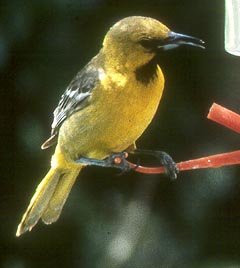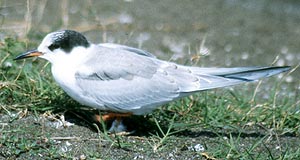

Photos © Carter L. Faust and Cynthia L. Hamilton
All rights reserved.
 |
 Photos © Carter L. Faust and Cynthia L. Hamilton All rights reserved. |
Both of these birds were discussed during the identification panel which I moderated at the July 2000 WFO conference in Kernville. The opinion of the panel was unanimous that the oriole was a first alternate male Hooded Oriole. It was photographed in May 1983 in San Rafael. The very graduated tail (visible on the underside) and the long curved bill eliminate Orchard Oriole.
Opinion on the tern was divided between Common and Arctic. The message board discussion brought up the possibility of a hybrid. An Arctic Tern hybridized with a Forster's Tern at the colony in Hayward, Alameda County last year, and the offspring was reportedly seen at least once this year. However I have no idea what the hybrid looks like, and this is not that bird.
I saw this tern in life at Rodeo Lagoon 26 September 1998 while leading a class field trip. We studied it at close range and identified it as an Arctic Tern, but when I saw this photograph, I was puzzled. Similar doubts are reflected in message board discussion which focused on "jizz." The problem with "jizz" is that it is cannot be unambiguous. Some participants felt the bill was too long, or the legs were too long for Arctic. But others disagreed. How then can we come to any firm conclusion just from the photo? Are there concrete field marks we can consistently apply and agree on?
I agree this bird is still in juvenal plumage. It can be aged by the dark crescents on the tertials and inner greater coverts. Usually Common Terns show these crescents as more ginger brown. Arctic Tern juveniles tend to have a colder, grayer overall coloration. One row of lesser coverts is partly visible below the overhanging scapulars. I think this row of feathers should be dark on Common Tern where it forms part of the carpal bar. Here it is the same gray color as the rest of the mantle although part of it is in shadow. The dark carpal bar on Arctic Tern tends to be confined more to the marginal coverts and is thus less extensive than on Common. It is concealed in this photo.
In the field, I paid particular attention to the distribution of dark on p10. On Common Tern the black on the outer web extends across the shaft and tip of this feather is entirely dark. On Arctic Tern the black does not extend across the shaft, and it contrasts more with the paler gray on the inner web and the white tongue on the inner web which almost reaches the tip. This difference apparently applies to all ages (Ainley, D.G., et al. 1980. Beached marine birds and mammals of the North American West Coast: A manual for their census and identification. U.S. Fish and Wildlife Service, Biological Services Program, FWS/OBS-80/03.)
Perhaps a more useful character in juvenal plumage, is the pattern on the secondaries. There is a dark secondary bar on Common Tern while Arctic shows all white secondaries in flight. Unfortunately the secondaries are concealed here but were able to confirm this mark for Arctic Tern in the field. At the WFO panel discussion, Steve Howell pointed out the dark area along the inner web of p6 extends beyond p5. Apparently on Common Tern the dark mark is shorter, not extending beyond the tip of p5. This is a very subtle distinction which needs further testing. I have not been able to confirm it in other photos.
Bill color seemed to me to be a problem for this bird. Field guides suggest that Arctic Terns should lose their reddish bill color by August/September, while Common Tern may retains it later. The identification panel in Kernville felt this character is more variable than generally appreciated. Since this month's mystery is an Arctic Tern, I would have to agree.
I was intrigued by the suggestion on the message board, that the lack of a pale eyelids was good for Arctic Tern. In viewing other photos, it appears to be true. Common Tern juveniles show a very narrow pale eyelids, at least at close range. Plate 93 in "Terns of Europe and North America" by Olsen and Larsson is a good example, but other photos of Common Tern seem to lack visible eyelids. E.g. pg. 104 in the April 1993 issue of Birding.
To view public comments or join the fray by adding your opinion, click here. Have fun!